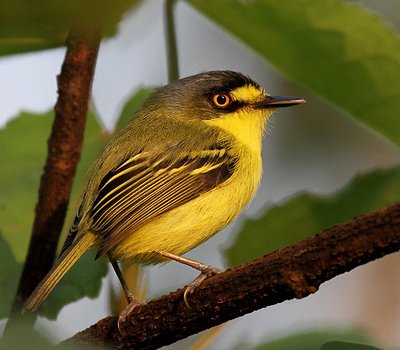State of Espírito Santo

Birding Espírito Santo
Espírito Santo is one of the states of southeastern Brazil, often referred to by the abbreviation ‘ES’. It is bordered by the Atlantic Ocean (E), the state of Bahia (N), the state of Minas Gerais (N and W), and the state of Rio de Janeiro (S). Its capital is Vitória and the largest city is Vila Velha, a satellite of Vitória. The name of the state literally means ‘holy spirit’ after the Holy Spirit of Christianity. With an extensive coastline (40% of the territory is on the coast), the state has some of the country’s main ports, but the beaches are the most significant tourist attractions. Vitória, the capital, is on an island, next to Guarapari, well known for its sands. In the extreme north is the district of Itaúnas, part of the municipality of Conceição da Barra, famous for its sand dunes and forró. Coastal cuisine is another attraction with moqueca capixaba and other local seafood dishes. Inland, there are many natural attractions such as the national parks of Pedra Azul and Caparaó, and the Italian and German colonies.At 46,180 square kilometers, it is about the size of Estonia, or half the size of Portugal, and has a variety of habitats including coastal planes, lakes, mountainous forests, mangroves and many others. The volcanic islands of Trindade and Martim Vaz, 715 kilometers east of Vitória in the southern Atlantic Ocean, also belong to Espírito Santo state.The main river in the state is the Doce (Sweet River). Other important river basins include the Santa Maria River Basin, the northern branch of rivers which join the sea at Vitória, and the Jucu River Basin which flows into the sea at roughly the same place. One of the most important lake districts in Brazil lies on the banks of the Doce River. The area contains some 26 large lakes, the biggest of which is called Juparanã Lake.Below are some of its top attractions and websites to the reserves and many places to stay where birding is an option. We welcome a proper introduction to this page from someone who knows the area well.
-
Conceição do Castelo
Satellite ViewThe only way to see what appears to be the last surviving population of six Cherry-throated Tanagers Nemosia rourei is to visit the Fazenda Pindobas IV with the two biologists employed there, Ana Cristina Venturini and Pedro Rogério de Paz. They charge US$200 per day plus expenses, and will pick you up at Vitória airport. Write to them at originalisnatura@originalisnatura.com.br The tanagers are becoming increasingly difficult to find. So far most people have seen the birds on the first day, one group saw them on the second, and in January 2001 we didn't see them at all. There are a number of other interesting Atlantic Forest species in these forest remnants, particularly Cinnamon-vented Piha Lipaugus lanioides. -
Reserva Biológica Augusto Ruschi - Alta Lombardia
Satellite ViewThe reserve is a good place to see Wied's Tyrant-manakin Neopelma aurifrons, from which the Serra do Mar Tyrant-manakin Neopelma chrysolophum has recently been split… -
Reserva Natural da Vale do Rio Doce
Satellite ViewSince the CVRD was privatised it has invested heavily in this reserve. There is a magnificent visitors centre, a hotel and more than 100km of good tracks through the forest. You need to get permission to enter the reserve (which is off limits to normal hotel residents).Birding is better at Linhares than Sooretama because of the much better access to the forest and because poachers are kept out. In three visits to Sooretama I have never seen the Red-billed Curassow Crax blumenbachii but heard it on one and saw it on another of the four days I spent recently at Linhares.
-
Number of bird species: 760
(As at May 2019)
-
Universidade Federal do Esp
Website
-
Clube de Observadores de Aves do Espírito Santo
WebsiteOrganização cujo o objetivo principal é a observação de aves e a sensibilização ambiental em todas as suas formas.
-
IBA Fazenda Pindobas IV e Arredores
InformationSatellite ViewIn Pindobas IV Farm, the rare tracheid Nemosia rourei (disappeared) has been rediscovered in 1998. The area is home to one of only two known populations of this critically endangered species that until its rediscovery had been found only in the locality -type and in two other locations in the center-south of Espírito Santo. -
NR Augusto Ruschi Biological Reserve
InformationSatellite ViewThe reserve is mostly covered in dense rainforest, with many species of flora, some of which are rare. The terrain is rugged, with altitudes ranging from 90 to 1,100 metres (300 to 3,610 ft). Streams rising in the reserve flow into the Doce, Timbuí and Piraqueaçú rivers. Protected birds in the reserve include the red-browed amazon (Amazona rhodocorytha), white-necked hawk (Leucopternis lacernulatus), Atlantic black-breasted woodpecker (Celeus torquatus tinnunculus), rufous-brown solitaire (Cichlopsis leucogenys), purple-winged ground dove (Claravis godefrida), black-bellied thorntail (Discosura langsdorffi), Salvadori's antwren (Myrmotherula minor) and brown-backed parrotlet (Touit melanonotus).
-
2018 [08 August] - Gilles Delforge - Atlantic Forest and Cerrado
PDF ReportThis was a hardcore 17 days birdwatching trip by 2 of us Gilles Willem and myself, Gilles Delforge. Both of us have a good experience of neotropical birding, but it was my first trip to Brazil, and the first serious one in south-east Brazil for Gilles.
-
José Silvério Lemos - Jornal das Aves
BLOGReports of birdwatching in Brazil by José Silvério Lemos
